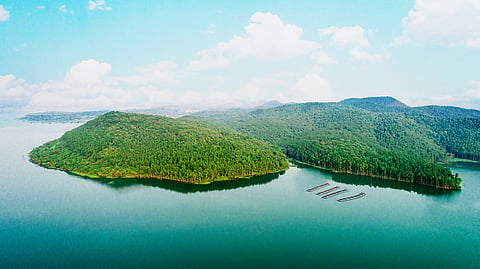
- Destinations
- Experiences
- Stay
- What's new
- Editor’s Picks
- Responsible Tourism
- CampaignsCampaigns
- Subscribe

A pristine state that encompasses a plethora of experiences - from cultural to culinary delights, waterfalls, temples and parks, Jharkhand is a gem slowly being unearthed in the Indian tourism circuit. In spite of its drive towards modernity, Jharkhand has a rural, almost emotional, attachment to its roots. With an immense potential to delight and amaze, the state is now on the map, and in the mind of travel enthusiasts looking for a new adventure.
Blessed with a divine natural landscape, Jharkhand is a sight for sore eyes, with its lush forests abound in flora and fauna. Amid monsoons, rivers roar with their gushing streams, the trees glisten with newfound colours, fruits and flowers blossom in the drenched forests and fields, reminding us of why this beautiful tapestry of life has inspired poets and writers for generations.
Wondrous Waterfalls
One of its bigger gifts that the sylvan state revels in are the waterfalls that dot its length and breadth. Embarking on a waterfall trail in Jharkhand will take you to the heart of tribal habitats, and the capital city of Ranchi boasts of five gorgeous waterfalls that you&rsquoll be sorry to miss
A rejuvenating dip at the Hundru falls, with its crystal clear water that flows down from the basalt rock ridges, is a monsoon delight. A worthy competitor is the scenic Dassam falls that lures nature lovers to dip their feet in its waters, surrounded by greenery and the sound of fluttering feathers. Flushed to the brim with water, the Jonha falls and its neighbour, the Sita falls, offer leisure coupled with bliss to the patrons of nature&rsquos watery dance at the vertical spectacles of magnificence.
Shining Saranda
Mary Davis aptly wrote - &ldquoI found far more answers in the woods than I ever did in the city." And the Saranda forest, which sprawls along the Jharkhand-Odisha border, is Jharkhand's prized jewel. Saranda means Elephants, and the forest is so named because it is home to a large number of elephants, in addition to being a sanctuary for the endangered flying lizard. Asia&rsquos largest sal forest, Saranda is also adorned by beautiful forest trails that lead to hills that offer picturesque sunset and sunrise, especially during the monsoon months where the forest, also called &lsquoThe land of seven hundred hills&rsquo, dons a vibrant green hue.
 A Hidden Gem
Counted among the lesser-known places in the state, Netarhat is a splendid experience, waiting to be discovered by adventure seekers. About 250kms from Ranchi, Netarhat falls in the Latehar district of Jharkhand, and is the highest point of Chotanagpur plateau, popularly known as Queen of Chotanagpur. With undulating roads, sprinkled with spiky pine and deodar trees, the boutique town is best known for the beautiful sunrise and sunset views that dazzle visitors, especially after a spell of heavy showers. And for those who seek to take their thrill quotient a notch higher, camping and trekking opportunities are aplenty here.
 Water Tourism
A calm boat ride in the settled waters of the majestic Maithon dam on Barakar river of Dhanbad is another major tourist attraction in the state. Boating around several islands in the lake, including Sabuj Deep and Chamoch Deep, is a must-do for visitors. Tilaiya, another dam on the river, offers a beautiful view of the local area, apart from being the perfect place to spot migratory birds in their full splendor. Massive fund allocation for the rejuvenation of the lakes in the state has risen hopes of making both Maithon and Tilaiya dam areas, lively hubs of activities.
The Tribal Way of Life
Worshipping Nature is an intrinsic part of the Jharkhand way of life, and the traditional ardour marks the many festivals that are celebrated in the state, especially by the tribal communities. Among many tribal festivals, the most important festive occasion is the Karma Puja - a worship of Karam devta, the god of power, youth and youthfulness - celebrated by the Baiga, Oraon, Binjhwari and Majhwar tribes of the state. This festival, celebrated on the 11th moon of the Hindu month of Bhadrapada which falls in the monsoon month of August/September. A spectacle of vibrancy and enthusiasm, villagers collect twigs from Karam tree and offer it to the deity, and the occasion is marked by ritualistic dances that are the pride of the cultural richness of Jharkhand.
The sal tree is the focal point of the tribal diversity, and Sarhul, where the tree is worshipped for health and prosperity, is an important festival where thousands of men, women and children sporting unique headgears, bandanas, anklets, bangles gather together for three days of festivities that culminate in a long procession filled with tribal revelry.
